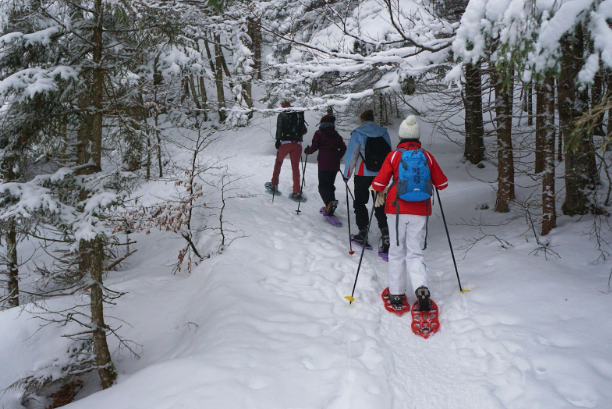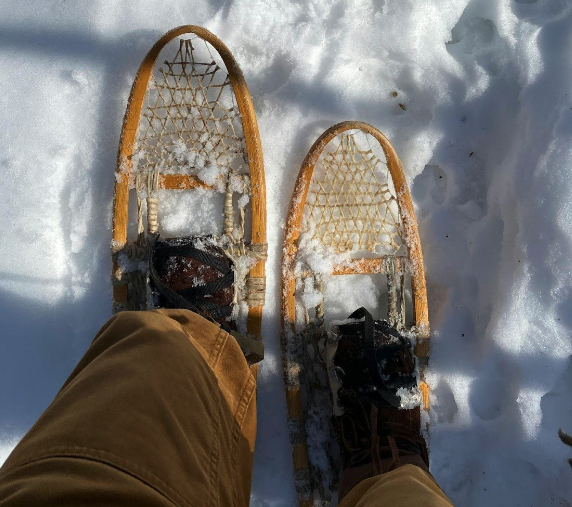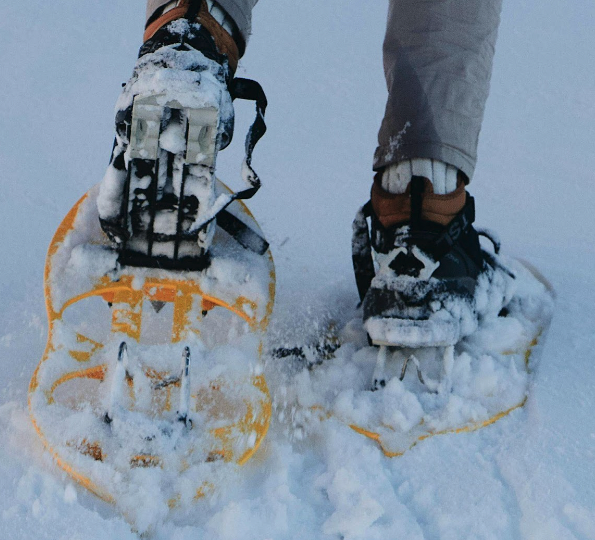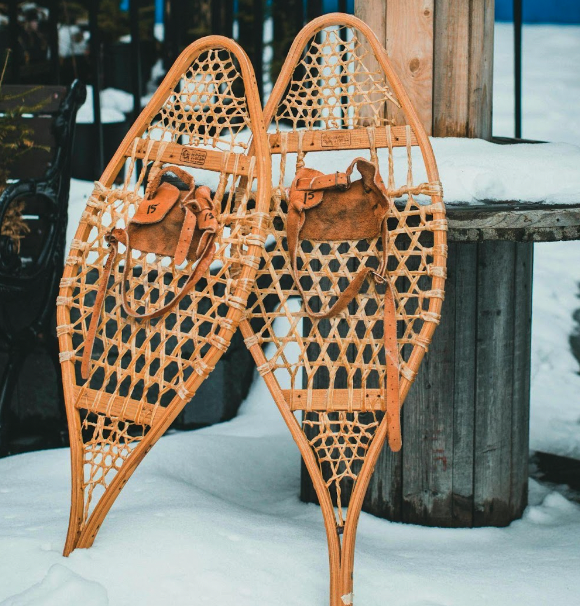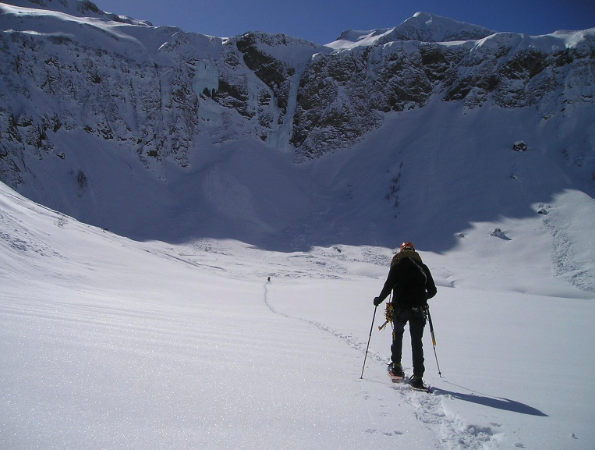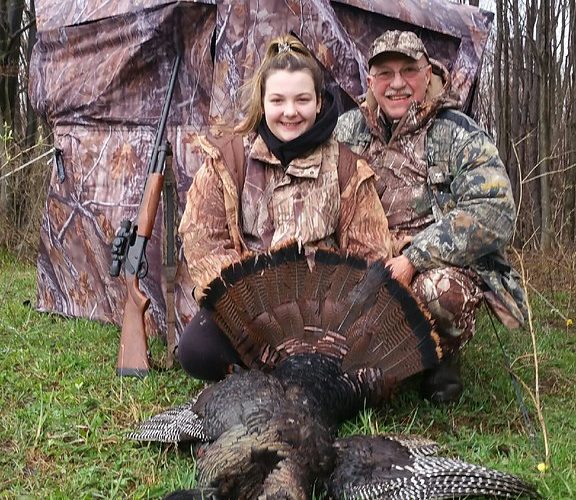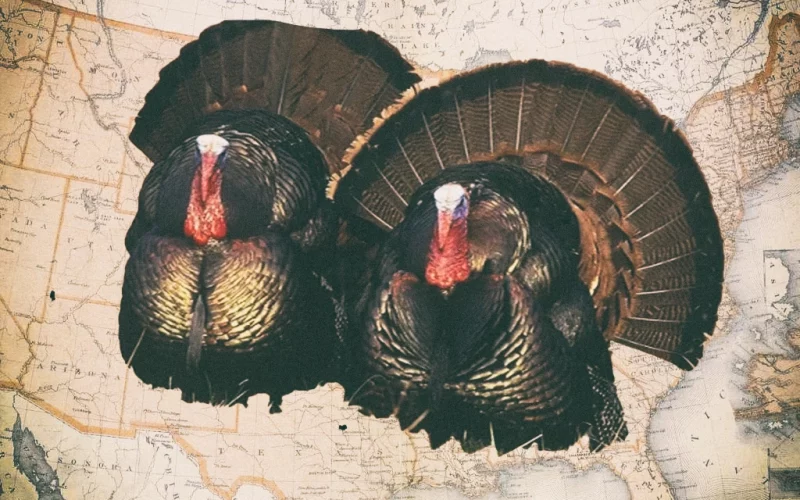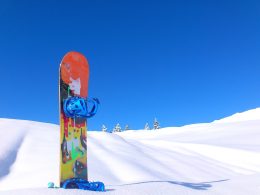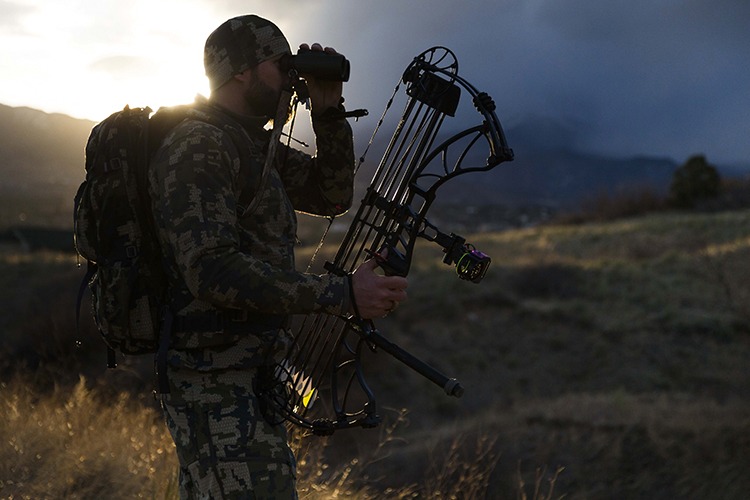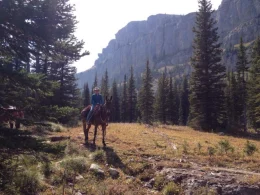Imagine the crunch of untouched snow beneath your feet, the crisp air filling your lungs, and the tranquil silence enveloping the winter landscape, interrupted only by your rhythmic strides.
Welcome to the enchanting world of snowshoeing.
This article will guide you through the many facets of snowshoes, from their rich historical roots to the modern techniques that will enhance your winter exploration.
Table of Contents
How Do Snowshoes Help You Walk in the Snow?
Snowshoes are clever tools designed to help you walk on snow without sinking. Their wide, flat design distributes your weight over a larger surface area, a principle known as flotation. This is similar to how a duck’s wide webbed feet allow it to paddle on the water without sinking.
Traditional snowshoes are made from wood and rawhide, while modern ones use lightweight metal and synthetic materials. They come in various sizes and shapes, tailored to different types of terrain and snow conditions.
In deep snow, using snowshoes can save energy as you won’t sink with each step, making your winter hike more efficient. With snowshoes, you can explore snowy landscapes without the need for cleared paths or trails.
The History and Evolution of Snowshoeing
Snowshoeing, as a means of winter travel, has a rich and varied history that spans centuries and cultures. It has seen many innovations and changes over the years but the core concept has remained the same.
Origins and Early Uses of Snowshoes
While there are branching theories, what we do know is that snowshoes were first used thousands of years ago by inhabitants of Central Asia, a necessity for hunting and traveling in heavy snow conditions.
These early snowshoes were made from wooden frames and animal hide, a design that was later adopted by indigenous tribes in North America for similar purposes in their snowy landscapes.
Modern Advancements in Snowshoe Design
Modern snowshoe design has come a long way since those rudimentary frames and hides. Today’s snowshoes are made with lightweight, durable materials like aluminum and plastic, making them easier to wear and maneuver.
They feature advanced bindings for better foot support and traction systems for increased stability on varied terrains. These advancements have transformed snowshoeing from a survival necessity into a popular recreational activity enjoyed by many.
The Technique of Snowshoeing
Mastering the art of snowshoeing extends beyond just wearing them. It involves understanding techniques that ensure safe, efficient movement across snowy landscapes.
Proper Foot Placement and Stride
Proper foot placement and stride are essential to maintain balance and efficiency while snowshoeing.
Keep your feet hip-width apart to prevent the snowshoes from clashing and to provide a stable base. During strides, lift your feet slightly higher than usual to clear the snow.
Unlike traditional walking, where the stride involves a heel-to-toe motion, snowshoeing requires a flatter foot placement. This helps distribute weight evenly across the snowshoe and prevents sinking into the snow.
Ascending and Descending Techniques
When ascending, lean forward slightly and press the front cleats of your snowshoes into the snow to create a secure grip. Use poles for better balance.
Descending requires a little more patience and care. Lean back slightly, keeping your body weight on the back of the snowshoes to avoid sliding. Again, use poles for stability and to control speed.
Traversing Techniques for Flat and Steep Terrain
Traversing flat terrain is straightforward: walk as you normally would but with a wider stance. For steep terrains, employ the sidestep or the herringbone technique.
The sidestep involves stepping sideways up the slope, keeping your body facing uphill. The herringbone technique, named after the pattern it creates in the snow, has you pointing your toes outward in a V-shape and stepping sideways. Both techniques help maximize grip and stability.
The Benefits of Snowshoeing
Snowshoeing, beyond its allure as a leisure activity, holds significant benefits for both physical and mental well-being. Additionally, it’s easy on the body, allowing a diverse range of individuals to participate.
Physical Health Benefits
- Cardiovascular Fitness: Snowshoeing offers a complete aerobic workout, improving heart health.
- Strength Training: The resistance encountered in snow helps build muscular strength, particularly in the lower body.
- Balance and Coordination: Navigating snowy terrains enhances balance and coordination skills.
- Calorie Burning: It is an effective way to burn calories, contributing to weight management.
Mental Health Benefits
Engaging in snowshoeing can be profoundly therapeutic. The peacefulness of nature creates a meditative environment, fostering a sense of calm and mindfulness.
This, in turn, aids in stress relief and promotes mental well-being. The delight of exploration and the satisfaction of physical exertion can boost mood and instill a sense of accomplishment.
Accessibility and Inclusivity of Snowshoeing
Snowshoeing stands as an accessible and inclusive outdoor activity. With a minimal learning curve and equipment requirements, it is easy to pick up, regardless of age or fitness level.
The adjustable pace of snowshoeing makes it adaptable to individual capabilities, thus promoting inclusivity. Also, snowshoeing offers an opportunity to enjoy the winter outdoors for those living in colder climates, where other activities might be restricted.
Snowshoeing vs. Walking in Snow
Walking in the snow can be challenging when the snow is too deep. Using snowshoes can significantly improve this excursion by providing superior footing, balance, and weight distribution.
When to Use Snowshoes
Snowshoes are particularly effective in deep and soft snow, allowing for a smoother, less exhausting passage by distributing your weight and preventing sinking. They offer excellent traction on slopes and icy terrains.
In situations of light snowfall or packed, well-trodden paths, regular winter walking might be more practical and efficient, eliminating the need for extra equipment. Using snowshoes in these conditions will cause you to drag your feet, tiring you out quickly.
The Rewards of Snowshoeing
In parts of the world that accumulate large quantities of snow, travel can be heavily restricted because of it. Using snowshoes for walking in the winter can get you access to some pretty remote areas. If you’re an explorer looking to find those special locations in the winter, snowshoes will be an essential part of your kit.
Conclusion
Snowshoeing is a highly adaptable and accessible winter activity that allows for exploration even in deep snow. It provides excellent footing, balance, and weight distribution, making it superior to regular walking in heavy snowfall conditions.
Trying it yourself is a superb way to enjoy the winter outdoors and reach remote, snowy destinations. It is a rewarding activity and one of the best ways to experience the unique joy of winter exploration firsthand.

